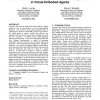Free Online Productivity Tools
i2Speak
i2Symbol
i2OCR
iTex2Img
iWeb2Print
iWeb2Shot
i2Type
iPdf2Split
iPdf2Merge
i2Bopomofo
i2Arabic
i2Style
i2Image
i2PDF
iLatex2Rtf
Sci2ools
ATAL
2008
Springer
2008
Springer
A model of gaze for the purpose of emotional expression in virtual embodied agents
Currently, state of the art virtual agents lack the ability to display emotion as seen in actual humans, or even in hand-animated characters. One reason for the emotional inexpressiveness of virtual agents is the lack of emotionally expressive gaze manner. For virtual agents to express emotion that observers can empathize with, they need to generate gaze - including eye, head, and torso movement - to arbitrary targets, while displaying arbitrary emotional states. Our previous work [18] describes the Gaze Warping Transformation, a method of generating emotionally expressive head and torso movement during gaze shifts that is derived from human movement data. Through an evaluation, it was shown that applying different transformations to the same gaze shift could modify the affective state perceived when the transformed gaze shift was viewed by a human observer. In this paper we propose a model of realistic, emotionally expressive gaze that builds upon the Gaze Warping Transformation by i...
ATAL 2008 | Gaze | Gaze Shifts | Intelligent Agents | Virtual Agent |
| Added | 12 Oct 2010 |
| Updated | 12 Oct 2010 |
| Type | Conference |
| Year | 2008 |
| Where | ATAL |
| Authors | Brent J. Lance, Stacy Marsella |
Comments (0)

